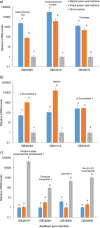Transcriptomic analysis of the honey bee (Apis mellifera) queen spermathecae reveals genes that may be involved in sperm storage after mating
- PMID: 33417615
- PMCID: PMC7793254
- DOI: 10.1371/journal.pone.0244648
Transcriptomic analysis of the honey bee (Apis mellifera) queen spermathecae reveals genes that may be involved in sperm storage after mating
Abstract
Honey bee (Apis mellifera) queens have a remarkable organ, the spermatheca, which successfully stores sperm for years after a virgin queen mates. This study uniquely characterized and quantified the transcriptomes of the spermathecae from mated and virgin honey bee queens via RNA sequencing to identify differences in mRNA levels based on a queen's mating status. The transcriptome of drone semen was analyzed for comparison. Samples from three individual bees were independently analyzed for mated queen spermathecae and virgin queen spermathecae, and three pools of semen from ten drones each were collected from three separate colonies. In total, the expression of 11,233 genes was identified in mated queen spermathecae, 10,521 in virgin queen spermathecae, and 10,407 in drone semen. Using a cutoff log2 fold-change value of 2.0, we identified 212 differentially expressed genes between mated and virgin spermathecal queen tissues: 129 (1.4% of total) were up-regulated and 83 (0.9% of total) were down-regulated in mated queen spermathecae. Three genes in mated queen spermathecae, three genes in virgin queen spermathecae and four genes in drone semen that were more highly expressed in those tissues from the RNA sequencing data were further validated by real time quantitative PCR. Among others, expression of Kielin/chordin-like and Trehalase mRNAs was highest in the spermathecae of mated queens compared to virgin queen spermathecae and drone semen. Expression of the mRNA encoding Alpha glucosidase 2 was higher in the spermathecae of virgin queens. Finally, expression of Facilitated trehalose transporter 1 mRNA was greatest in drone semen. This is the first characterization of gene expression in the spermathecae of honey bee queens revealing the alterations in mRNA levels within them after mating. Future studies will extend to other reproductive tissues with the purpose of relating levels of specific mRNAs to the functional competence of honey bee queens and the colonies they head.
Conflict of interest statement
The authors have declared that no competing interests exist.
Figures




References
Publication types
MeSH terms
LinkOut - more resources
Full Text Sources
Other Literature Sources

